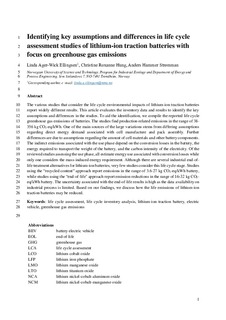| dc.contributor.author | Ellingsen, Linda Ager-Wick | |
| dc.contributor.author | Hung, Christine Roxanne | |
| dc.contributor.author | Strømman, Anders Hammer | |
| dc.date.accessioned | 2017-11-17T10:37:38Z | |
| dc.date.available | 2017-11-17T10:37:38Z | |
| dc.date.created | 2017-07-12T11:01:36Z | |
| dc.date.issued | 2017 | |
| dc.identifier.citation | Transportation Research Part D: Transport and Environment. 2017, 55, 82-90. | nb_NO |
| dc.identifier.issn | 1361-9209 | |
| dc.identifier.uri | http://hdl.handle.net/11250/2466869 | |
| dc.description.abstract | The various studies that consider the life cycle environmental impacts of lithium-ion traction batteries report widely different results. This article evaluates the inventory data and results to identify the key assumptions and differences in the studies. To aid the identification, we compile the reported life cycle greenhouse gas emissions of batteries. The studies find production-related emissions in the range of 38-356 kg CO2-eq/kWh. One of the main sources of the large variations stems from differing assumptions regarding direct energy demand associated with cell manufacture and pack assembly. Further differences are due to assumptions regarding the amount of cell materials and other battery components. The indirect emissions associated with the use phase depend on the conversion losses in the battery, the energy required to transport the weight of the battery, and the carbon intensity of the electricity. Of the reviewed studies assessing the use phase, all estimate energy use associated with conversion losses while only one considers the mass-induced energy requirement. Although there are several industrial end-of- life treatment alternatives for lithium-ion batteries, very few studies consider this life cycle stage. Studies using the “recycled content” approach report emissions in the range of 3.6-27 kg CO2-eq/kWh battery, while studies using the “end-of-life" approach report emission reductions in the range of 16-32 kg CO2- eq/kWh battery. The uncertainty associated with the end-of-life results is high as the data availability on industrial process is limited. Based on our findings, we discuss how the life emissions of lithium-ion traction batteries may be reduced. | nb_NO |
| dc.language.iso | eng | nb_NO |
| dc.publisher | Elsevier | nb_NO |
| dc.rights | Attribution-NonCommercial -NoDerivatives 4.0 Internasjonal | * |
| dc.rights.uri | http://creativecommons.org/licenses/by-nc-nd/4.0/deed.no | * |
| dc.title | Identifying key assumptions and differences in life cycle assessment studies of lithium-ion traction batteries with focus on greenhouse gas emissions | nb_NO |
| dc.type | Journal article | nb_NO |
| dc.type | Peer reviewed | nb_NO |
| dc.description.version | acceptedVersion | nb_NO |
| dc.source.pagenumber | 82-90 | nb_NO |
| dc.source.volume | 55 | nb_NO |
| dc.source.journal | Transportation Research Part D: Transport and Environment | nb_NO |
| dc.identifier.doi | 10.1016/j.trd.2017.06.028 | |
| dc.identifier.cristin | 1481997 | |
| dc.relation.project | Norges forskningsråd: 209697 | nb_NO |
| dc.description.localcode | (C) 2017 Elsevier Ltd. All rights reserved. Author's post-print is released with a Creative Commons Attribution Non-Commercial No Derivatives License. This is the authors' accepted and refereed manuscript to the article. Locked until 2019-07-01. | nb_NO |
| cristin.unitcode | 194,64,25,0 | |
| cristin.unitname | Institutt for energi- og prosessteknikk | |
| cristin.ispublished | true | |
| cristin.fulltext | postprint | |
| cristin.qualitycode | 2 | |

